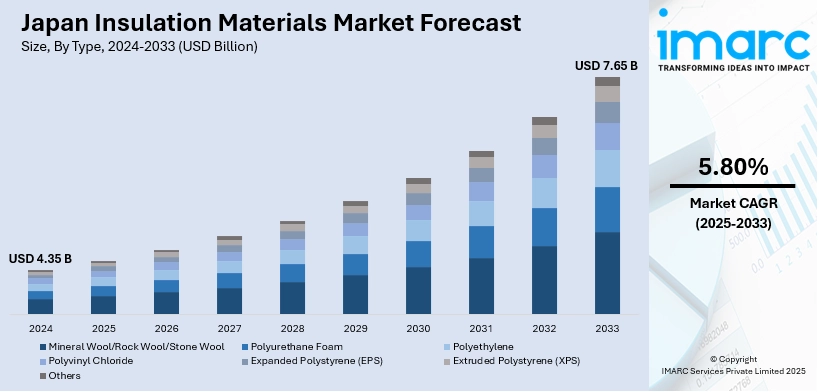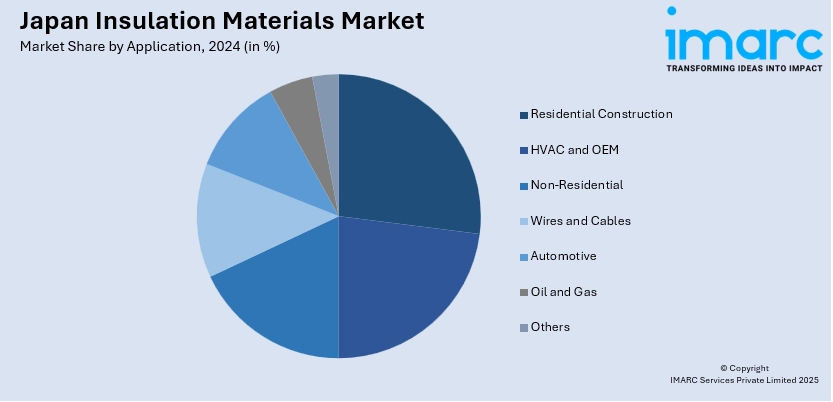
Japan Insulation Materials Market Size, Share, Trends and Forecast by Type, Application, and Region, 2025-2033
Japan Insulation Materials Market Overview:
The Japan insulation materials market size reached USD 4.35 Billion in 2024. Looking forward, IMARC Group expects the market to reach USD 7.65 Billion by 2033, exhibiting a growth rate (CAGR) of 5.80% during 2025-2033. The market is driven by stringent energy efficiency regulations and reforms in Japan’s building codes, which mandate thermal performance standards. Retrofitting older buildings and public infrastructure is creating consistent demand for advanced insulation technologies. Meanwhile, expanding cold storage facilities, industrial retrofits, and temperature-controlled logistics are supporting material innovations and adoption, further augmenting the Japan insulation materials market share.
|
Report Attribute
|
Key Statistics
|
|---|---|
|
Base Year
|
2024 |
|
Forecast Years
|
2025-2033
|
|
Historical Years
|
2019-2024
|
| Market Size in 2024 | USD 4.35 Billion |
| Market Forecast in 2033 | USD 7.65 Billion |
| Market Growth Rate 2025-2033 | 5.80% |
Japan Insulation Materials Market Trends:
Energy Conservation Policies and Building Code Reforms
Japan has reinforced its energy efficiency targets in the building sector as part of its broader decarbonization agenda. The 2025 revision of the Energy Conservation Act mandates stricter insulation performance standards across new constructions and large-scale renovations. These regulatory measures are driving demand for high-performance insulation in residential, commercial, and institutional structures. Developers are prioritizing materials such as polyurethane foam, mineral wool, and vacuum insulation panels that support low thermal conductivity and long-term energy savings. Additionally, the ZEH (Zero Energy House) program continues to incentivize builders to enhance thermal performance in homes, directly fueling insulation uptake. On April 15, 2025, NIPPON KINZOKU CO., LTD. announced the development of its proprietary FI (Fine Insulation) finish, an insulated stainless steel surface pre-coated with an inorganic layer approximately 1μm thick. This innovation offers over 50 MΩ surface insulation resistance, withstands temperatures up to 850°C, and supports steel strip widths up to 500 mm and thicknesses from 0.05 to 0.15 mm. Designed to reduce post-processing, it enhances miniaturization in electronics while aligning with the company’s carbon neutrality goals. Municipalities in colder regions such as Hokkaido and Tohoku are enforcing localized insulation benchmarks to reduce reliance on heating appliances, accelerating regional demand. Building owners are increasingly considering lifecycle operational costs, favoring insulation systems that enable sustained utility savings and reduced emissions. This alignment of environmental regulation, economic efficiency, and construction activity is playing a central role in Japan insulation materials market growth.

To get more information on this market, Request Sample
Industrial Energy Efficiency and Cold Chain Expansion
Japan’s manufacturing sector, logistics infrastructure, and food processing industries are contributing significantly to the growth of high-performance insulation solutions. Industrial facilities are under pressure to minimize thermal losses across piping, equipment, and storage areas to meet corporate sustainability goals. Cold storage capacity, essential for pharmaceutical, food, and semiconductor logistics, is expanding rapidly, requiring advanced insulation panels, foams, and thermal barriers. The government's promotion of hydrogen and LNG terminals is also creating demand for cryogenic insulation capable of withstanding extreme temperatures. In tandem, manufacturers are introducing multi-layered insulation systems that improve safety, reduce energy leakage, and withstand corrosive environments. With the rise of e-commerce and temperature-sensitive delivery services, insulated packaging and container systems are seeing widespread use. As industry operators pursue cost savings and operational stability, insulation has become integral to facility upgrades and compliance. On September 19, 2024, Asahi Kasei launched a new grade of LASTAN™, a flame-retardant nonwoven fabric that enhances EV battery safety through superior insulation against thermal runaway. The material withstands 1,300°C flames while keeping the reverse-side temperature below 400°C, resists 200–500 µm particle impacts, and provides electrical insulation up to 3.5 kV at 1 mm thickness. With a Limiting Oxygen Index (LOI) of 50+, UL94 5VA flame rating, and high flexibility at 0.8 mm thickness, it offers durable and processable insulation for battery components. These applications are increasing insulation materials consumption across Japan’s high-tech and temperature-controlled infrastructure, reinforcing long-term market relevance.
Japan Insulation Materials Market Segmentation:
IMARC Group provides an analysis of the key trends in each segment of the market, along with forecasts at the country and regional levels for 2025-2033. Our report has categorized the market based on type and application.
Type Insights:
- Mineral Wool/Rock Wool/Stone Wool
- Polyurethane Foam
- Polyethylene
- Polyvinyl Chloride
- Expanded Polystyrene (EPS)
- Extruded Polystyrene (XPS)
- Others
The report has provided a detailed breakup and analysis of the market based on the type. This includes mineral wool/rock wool/stone wool, polyurethane foam, polyethylene, polyvinyl chloride, expanded polystyrene (EPS), extruded polystyrene (XPS), and others.
Application Insights:

- Residential Construction
- HVAC and OEM
- Non-Residential
- Wires and Cables
- Automotive
- Oil and Gas
- Others
The report has provided a detailed breakup and analysis of the market based on the application. This includes residential construction, HVAC and OEM, non-residential, wires and cables, automotive, oil and gas, and others.
Regional Insights:
- Kanto Region
- Kansai/Kinki Region
- Central/Chubu Region
- Kyushu-Okinawa Region
- Tohoku Region
- Chugoku Region
- Hokkaido Region
- Shikoku Region
The report has also provided a comprehensive analysis of all major regional markets. This includes Kanto Region, Kansai/Kinki Region, Central/Chubu Region, Kyushu-Okinawa Region, Tohoku Region, Chugoku Region, Hokkaido Region, and Shikoku Region.
Competitive Landscape:
The market research report has also provided a comprehensive analysis of the competitive landscape. Competitive analysis such as market structure, key player positioning, top winning strategies, competitive dashboard, and company evaluation quadrant has been covered in the report. Also, detailed profiles of all major companies have been provided.
Japan Insulation Materials Market Report Coverage:
| Report Features | Details |
|---|---|
| Base Year of the Analysis | 2024 |
| Historical Period | 2019-2024 |
| Forecast Period | 2025-2033 |
| Units | Billion USD |
| Scope of the Report |
Exploration of Historical Trends and Market Outlook, Industry Catalysts and Challenges, Segment-Wise Historical and Future Market Assessment:
|
| Types Covered | Mineral Wool/Rock Wool/Stone Wool, Polyurethane Foam, Polyethylene, Polyvinyl Chloride, Expanded Polystyrene (EPS), Extruded Polystyrene (XPS), Others |
| Applications Covered | Residential Construction, HVAC and OEM, Non-Residential, Wires and Cables, Automotive, Oil and Gas, Others |
| Regions Covered | Kanto Region, Kansai/Kinki Region, Central/Chubu Region, Kyushu-Okinawa Region, Tohoku Region, Chugoku Region, Hokkaido Region, Shikoku Region |
| Customization Scope | 10% Free Customization |
| Post-Sale Analyst Support | 10-12 Weeks |
| Delivery Format | PDF and Excel through Email (We can also provide the editable version of the report in PPT/Word format on special request) |
Key Questions Answered in This Report:
- How has the Japan insulation materials market performed so far and how will it perform in the coming years?
- What is the breakup of the Japan insulation materials market on the basis of type?
- What is the breakup of the Japan insulation materials market on the basis of application?
- What is the breakup of the Japan insulation materials market on the basis of region?
- What are the various stages in the value chain of the Japan insulation materials market?
- What are the key driving factors and challenges in the Japan insulation materials market?
- What is the structure of the Japan insulation materials market and who are the key players?
- What is the degree of competition in the Japan insulation materials market?
Key Benefits for Stakeholders:
- IMARC’s industry report offers a comprehensive quantitative analysis of various market segments, historical and current market trends, market forecasts, and dynamics of the Japan insulation materials market from 2019-2033.
- The research report provides the latest information on the market drivers, challenges, and opportunities in the Japan insulation materials market.
- Porter's five forces analysis assist stakeholders in assessing the impact of new entrants, competitive rivalry, supplier power, buyer power, and the threat of substitution. It helps stakeholders to analyze the level of competition within the Japan insulation materials industry and its attractiveness.
- Competitive landscape allows stakeholders to understand their competitive environment and provides an insight into the current positions of key players in the market.
Need more help?
- Speak to our experienced analysts for insights on the current market scenarios.
- Include additional segments and countries to customize the report as per your requirement.
- Gain an unparalleled competitive advantage in your domain by understanding how to utilize the report and positively impacting your operations and revenue.
- For further assistance, please connect with our analysts.
 Request Customization
Request Customization
 Speak to an Analyst
Speak to an Analyst
 Request Brochure
Request Brochure
 Inquire Before Buying
Inquire Before Buying




.webp)




.webp)












